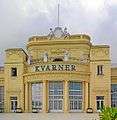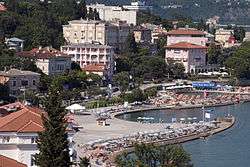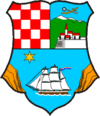Opatija
| Opatija | |||||
|---|---|---|---|---|---|
| Town | |||||
Opatija | |||||
| |||||
 Opatija Location of Opatija within Croatia | |||||
| Coordinates: 45°20′N 14°18′E / 45.333°N 14.300°E | |||||
| Country |
| ||||
| County |
| ||||
| Government | |||||
| • Mayor | Ivo Dujmić (2009-)[1] | ||||
| Elevation | 0 m (0 ft) | ||||
| Population (2011[2]) | |||||
| • Town | 11,659 | ||||
| • Urban | 6,657 | ||||
| Time zone | CET (UTC+1) | ||||
| • Summer (DST) | CEST (UTC+2) | ||||
| Postal code | 51 410 | ||||
| Area code(s) | 051 | ||||
| Website | opatija.hr | ||||
Opatija (pronounced [ɔpǎtija]; German: Sankt Jakobi; Italian: Abbazia; Hungarian: Abbázia) is a town in western Croatia, just southwest of Rijeka on the Adriatic coast. As of 2011, the town had 11,659 inhabitants in total, of which 6,657 lived in the urban settlement.
Geography
Opatija is situated in the Gulf of Kvarner in a sheltered position at the foot of Učka mountain, with Vojak peak at 1401 m. Opatija is located 90 km from Trieste by rail and 82 km from Pula by road. The city is geographically on the Istrian peninsula, though it is not in Istria County, but Primorje-Gorski Kotar County.
It is a popular summer and winter resort, with average temperatures of 10 °C in winter, and 25 °C in summer. Opatija is surrounded by beautiful woods of bay laurel. The whole sea-coast to the north and south of Opatija is rocky and picturesque, and contains several smaller winter resorts.
History
Opatija was included in the territory of the Liburni, a pre-Roman Illyrian people. In Roman times, the area was home to several patrician villas connected to the nearby town of Castrum Laureana, the modern Lovran.
In the Middle Ages the current town's territory was divided between Veprinac (now a locality of Opatija, perhaps home to a small fishing port) and Kastav, where the fisherman village of Veprinac. The Benedictine Abbey of St. Jacob was mentioned for the first time in 1453, and around it a small hamlet developed during the centuries.
The town's modern history began in 1844, when Iginio Scarpa, a rich merchant from Rijeka, founded Villa Angiolina. In 1872 Railways came to Matulji and thus opened the path for the development of tourism in Opatija and Lovran. In 1882 Friedrich Julius Schüler, the Managing Director of Southern Railways started the construction of villas and hotels in Opatija and Lovran, and was responsible for the unique lungomare and parks (the Company engaged Carl Schubert, director of the Viennese Emperial-Royal Society for the construction of parks). In 1882, Cesar-royal Society of the Southern railway from Vienna, led by Julius Schuler, purchased the first land with Villa Angiolina in Opatija. There, in the park Angiolina today stands FJ Schüler's bust, the work of the sculptor Hans Rathausky.
In 1887, Heinrich von Littrow established the "Union Yacht Club Quarnero" in Opatija (founded in June/July 1886) - the first sailing club on the Adriatic. In 1889 The Austrian government officially declared Abbazia ( Opatija) as the first climatic seaside resort on the Adriatic. After the hotels, the building of villas started, for the needs of more demanding guests. The first villa was the "Amalia", in the immediate vicinity of the hotel "Quarnero" in 1890 as hotel's annex. Opatija's first guide was published in 1883 in Vienna with the title Abbazia, Idylle von der Adria. The same year saw the publication of Abbazia und seine Umgebung by Noe Heinrich, who in 1884 published Tagebuch aus Abbazia (Diary from Opatija). Joseph Rable printed Curort und Seebad Abbazia (Spa and the bathing beach in Opatija), and Peter von Radics wrote a guidebook simply titled Abbazia. Opatija is best known nowadays as the venue for a chess tournament devoted to the King’s Gambit in 1912.
The Austrian emperor Franz Joseph I used to spend several months here during the winter. Many of these late 19th-century luxury hotels and villas have survived to present times. During World War I the Hotel Icicii was converted to a military hospital. The accompanying pictures show the nursing staff and wounded at lunch, on the grounds, and receiving care.
In 1920 Opatija was assigned to Italy. Two years later, with the advent of Fascism, the Italian government started a program of forced italianization of the population, and most of the public positions were assigned to Italian-speaking citizens. The upper floor of Villa Amalia was built in 1930, and the building was renovated to become the summer residence of the House of Savoy.
In 1947 Opatija was given to Yugoslavia; most of the Italian-speaking population, whose percentage had substantially increased in the past years, emigrated to Italy. In 1963 the Hotel Adriatic, by the architect Andrija Cicin-Sain and his team was completed. Hotel "Adriatic" was the first hotel built in Opatija after the Austro-Hungarian era. The rooms of hotel "Adriatic" have been described as novelties in the hospitality industry. The "Casino Rosalia" was opened in Opatija – the first casino in Eastern Europe. In 1981 the Hotel "Admiral" and marina (200 berths and 40 dry berths) were completed. After the breakup of Yugoslavia which began in 1991, the town became part of Croatia.
Landmarks
| Historical population of Opatija | ||
|---|---|---|
| Year | Pop. | ±% |
| 1880 | 4,775 | — |
| 1890 | 5,994 | +25.5% |
| 1900 | 8,430 | +40.6% |
| 1910 | 11,825 | +40.3% |
| 1921 | 9,625 | −18.6% |
| 1931 | 11,865 | +23.3% |
| 1948 | 10,098 | −14.9% |
| 1953 | 9,920 | −1.8% |
| 1961 | 11,154 | +12.4% |
| 1971 | 12,242 | +9.8% |
| 1981 | 13,614 | +11.2% |
| 1991 | 13,566 | −0.4% |
| 2001 | 12,719 | −6.2% |
| 2011 | 11,659 | −8.3% |
| Source: Naselja i stanovništvo Republike Hrvatske 1857–2001, DZS, Zagreb, 2005 | ||
The old 14th-century Benedictine abbey, Opatija Sv. Jakova ("Abbey of Saint Jacob"), from which the town derives its name (opatija means "abbey" in Croatian) is located in Park Svetog Jakova or Saint James's Park. Saint Jacob's church, built in 1506 and enlarged in 1937, now stands on the same spot. The neo-Romanesque Church of the Annunciation with its pronounced green cupola, was designed in 1906 by architect Karl Seidl.
Another sight is the Villa Angiolina, built in 1844 by Iginio Scarpa. This villa, transformed into a museum. Since 1844. Villa Angiolina had many prominent guests
Opatija is known for the Maiden with the seagull, a statue by Zvonko Car (1956), which is positioned on a promontory by the Juraj Šporer art pavilion. It has turned into one of symbols of Opatija. A gilded variant of the statue Madonna, that once stood here but was demolished by communists after the end of World War II, now stands in front of Saint Jacob's Church.
The town park Angiolina contains many species of plants from all over the world. It has been protected since 1968. Close-by, vis-a-vis Hotel Imperial, stands the statue The Fountain - Helios and Selena, a work of the Austrian sculptor Hans Rathautsky from 1889. There is a 12 km-long promenade along the entire riviera, the Lungomare from Volosko, via Opatija, to Lovran and a 7 km-long forest path walk, the Šetalište Carmen Sylve, named after Elisabeth of Wied, Queen consort of Romania, widely known by her literary name of Carmen Sylva.
Film location
Several scenes of "The Legacy Run" [3] have been shot in Opatija. The movie, in good part shot in the Opatja-Rijeka region, is the conceptual prequel of the international TV Series "Sport Crime".[4]
Notable people
- Theodor Billroth (1829–1894), died in Opatija
- Drago Gervais (1904–1957), born in Opatija
- Kosta Hakman (1899–1961), died in Opatija
- Franz Graf von Meran (1839–1891), died in Opatija
- Gustav Mahler (1860–1911), vacationed several times in Opatija (Abbazia)
- Andrija Mohorovičić (1857–1936), born in Opatija
- Leo Sternbach (1908–2005), born in Opatija
- Gyula Szapáry (1832–1905), died in Opatija
Gallery
 Maiden with the Seagull
Maiden with the Seagull St. Jacob's Church
St. Jacob's Church Villa Angiolina
Villa Angiolina Hotel Kvarner
Hotel Kvarner- View of Opatija
- Hotel Opatija
 Fiat Mokarabia at the Chocolate Festival
Fiat Mokarabia at the Chocolate Festival.jpg) Museum
Museum Miroslav Krleža statue
Miroslav Krleža statue Opatija at night
Opatija at night "Ambasador" Hotel
"Ambasador" Hotel
Twin towns—Sister cities
-
 Castel San Pietro Terme, Italy
Castel San Pietro Terme, Italy -
 Ilirska Bistrica, Slovenia
Ilirska Bistrica, Slovenia -
 Balatonfüred, Hungary
Balatonfüred, Hungary -
 Carmagnola, Italy
Carmagnola, Italy -
 Bad Ischl, Austria
Bad Ischl, Austria -
 Ferrara, Italy
Ferrara, Italy
Notes
- ↑ "Grad Opatija • Gradonačelnik".
- ↑ "Popis stanovništva 2011.".
- ↑ "The Legacy Run". 1 January 2000 – via IMDb.
- ↑ "Sport Crime".
- ↑ "Opatija's Twin towns — Sister cities". © 2004–2011 Opatija.net.
References
-
 This article incorporates text from a publication now in the public domain: Chisholm, Hugh, ed. (1911). "Opatija". Encyclopædia Britannica (11th ed.). Cambridge University Press.
This article incorporates text from a publication now in the public domain: Chisholm, Hugh, ed. (1911). "Opatija". Encyclopædia Britannica (11th ed.). Cambridge University Press.
External links
| Wikimedia Commons has media related to Opatija. |
- Official website
- Opatija LIVE WebCams
- Opatija Weather Station - Current Weather Conditions at Opatija
- Remisens hotels
- Apartments - Opatija, Croatia
Coordinates: 45°20′N 14°18′E / 45.333°N 14.300°E





